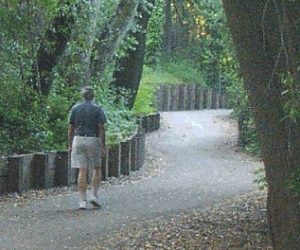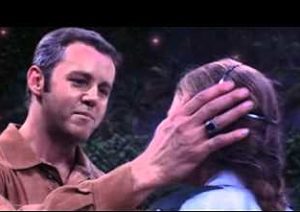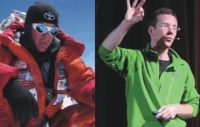Let’s not demean ourselves, demean our dreams by pushing them off on some list of things we want to do before we die…the promise of this moment is all we have.
~ Charlie Wittmack ~
The Journey Begins with a Single Step
Some 2600 years ago, the Chinese philosopher Lau Tzu wrote,
The tallest tree grows from the smallest sprout.
The tallest tower is built from a pile of dirt.
A journey of a thousand miles begins beneath your feet.
Lau Tzu could very well have been speaking of the Hero’s Journey. We cannot take our whole journey all at once. We need to begin with a single step and then follow that with another step, and then another. And at each point we need to focus mindfully on the step we are taking, living it fully and taking from it the experience and knowledge we will need for the rest of our journey and our lives.
 I recently came across a TED Talk that reminded me of Lau Tsu’s point. The talk was given by Charlie Wittmack, the first American to complete the “Pond and Peak” sports double in which he both swam the English Channel and climbed Mount Everest. In the video, Wittmack talks about his goals to climb Everest and swim the channel and how he made those “future” events part of his meaningful present. I’ll review the video in a minute, but first Whittmack reminded me of several experiences I had while teaching.
I recently came across a TED Talk that reminded me of Lau Tsu’s point. The talk was given by Charlie Wittmack, the first American to complete the “Pond and Peak” sports double in which he both swam the English Channel and climbed Mount Everest. In the video, Wittmack talks about his goals to climb Everest and swim the channel and how he made those “future” events part of his meaningful present. I’ll review the video in a minute, but first Whittmack reminded me of several experiences I had while teaching.
Get this Class out of the Way!
Twice each year, school academic counselors would come to my classes to help students plan their programs for the coming years. On every visit, the counselors focused on the children’s futures, emphasizing that what students were doing was only preparation for “real life” later on. Often counselors would use phrases such as “You need to get this required class out of the way” or “Joining school activities or clubs will look good on your college resume and make you more attractive to the colleges.”
While they didn’t realize it, counselors were promoting a subtext: what students were doing now matters only in terms of their future. Of course, on a certain level, this was true. But on a more important level, especially with adolescents who are actively engaged in the moment as they built personal identities, the message was more subtle and insidious: you’re life now isn’t “real;” it’s only preparation for your future.
This message was reinforced when they suggested that students get certain classes “out of the way,” rather than encouraging students to engage in the classes for the growth and learning they provide today. The classes most often mentioned as “in the way” of students’ futures were non-academic classes such as physical education, health and art. Ironically, these are the classes which could give students some of the most healthy, rewarding and profound experience in their education and which would enrich their lives for decades to come.
The point I’m making is that, while we need goals for the future, the most valuable and important thing we can do in life is to fully and mindfully engage in the present. In fact, the present moment is all we have.
Honoring the Moment and What it Can Bring
I’m reminded of a story I used to share with my high school senior class. In his wonderful book Travels, Michael Crichton tells the story about a trek he made in the Himalayas of Nepal.
Late one afternoon, as they headed back to their camp after a long hike, Crichton was feeling tired, hungry and irritable. Suddenly, his guide stopped and pointed toward the scene before them. “Kali-Gandaki,” he said. “Yah, right,” Crichton said. “Let’s go. I’m tired and I’m hungry, and I want to get back.” “No, no” the guide insisted. “Kali-Gandaki, Kali-Gandaki,” and he pointed emphatically at the scene below them. Crichton looked quickly and then said, “OK, let’s go.” The guide shrugged and led them back to their camp. Only later did Crichton realize that, because of his impatience and arrogance, he had missed seeing the Kali-Gandaki Gorge, the deepest canyon in the world.
What Crichton learned—and what we must learn—is that while we need to keep our goals in mind, we must also be mindful of this minute and what it can bring to our lives: which brings me to the key point Wittmack made in his discussion:
“Our dreams are often very intangible. They’re often far off in the future. If we’re going to have success, we’re going to have to figure out how to make them more tangible and more immediate. We have to take them from the future and bring them into today.”
“Small Moves, Ellie. Small Moves”

In the movie “Contact,” Ellie Arroway is impatient to let the world see what she has seen. The alien (in the form of her father) tells her to be patient: “Small moves, Ellie. Small moves.”
There is a valuable lesson for us in how Whitmack made his future goal today’s reality. He was an Iowa farm boy, about as far from a channel swimmer or mountain climber as one could be. He had to figure out, as he says, “How do we get there from here.” While he was speaking of getting to the peaks of Everest from the plains Iowa, from being a non-swimmer to someone who could swim in icy water for 18 hours non-stop, he was also speaking metaphorically about managing life’s great Hero’s Journeys by turning them into everyday “mini” journeys that both motivate and instruct.
According to Wittmack, he did this by breaking his dream of climbing Everest into smaller steps that he could take each month, each day (watch the video for examples).
“So every few years had a long-term goal, every few months I had a short-term goal and every day I had a few action items that were things I had to accomplish to begin walking down that path to where I wanted to be.”
By breaking his greatest journeys (to climb Everest and to swim the English Channel) into smaller, “action items,” he brought his long-term goal into the reality of his everyday present. More importantly, he made each step he took not “something to be gotten out of the way” (as my high school counselors would say), but a “living,” in-this-moment project worthy of all of the mindfulness and effort he could give it.
Using the Resources We Have
By shifting his perspective from the full journey to each step of the journey, Wittmack also learned to see the resources he had as tools to help him on the greater quest. “I learned very quickly that one of the keys for me…was to be creative, to use the things I had to get the things I wanted.”
He also learned another important lesson: “The failures tend to outnumber the successes by about five to one.” This brings up one of the most important points I make about success in our personal Hero’s Journeys. We should think of our “failures” not as failures, but as discoveries: actions that proved ineffective in the moment, but which brought us the learning and greater perspective we need to turn short-term “failures” into a long-term success.
When viewed in this context, failures actually become successes because they teach us something, make us stronger and fortify our resolve, focus and commitment. This learning-rather-than-failing perspective also brings us back to Charlie Wittmack’s key point about fully valuing and respecting our present by not subordinating it to our future.
We can navigate even life’s most intimidating Hero’s Journeys by focusing on them one step at a time. When we value the individual steps fully and mindfully, they become not something to be “gotten out of the way” for the promise of tomorrow, but, as Hamlet says, “enterprises of great pith and moment.”
I conclude with Charlie Wittmack’s closing comment:
“Let’s not demean ourselves, demean our dreams by pushing them off on some list of things we want to do before we die. Today we are together in this moment, and this moment is what we have, we have the promise of this moment. Every one of you in this room has the skills that you need to take that next step. Each of you is cloaked in the strength that has come from your success. Each of you is filled with the ambition that has come from your failure. And now it’s time for all of us to take that next step, which is, very simply, to reach.”

